Sunday 21 December 2008 at 20h42
Exactly one year ago, I already announced you here that the Vuelta 2009 -which will take place from 29 August till 20 September- will start in The Netherlands, in Assen, but it was only on Wednesday 17 December that the full route of the Tour of Spain 2009 has officially been announced.
That day we discovered that after the prologue in Assen and the first stage which stays in the province of Drenthe (for a stage between Assen and Emmen) this 64th edition of the Vuelta a España will have another stage which is 100% Dutch (Zutphen > Venlo) and a stage which will connect The Netherlands with Belgium (Venlo > Liège) before a huge transfer to Spain.
CONTINUE READING AFTER THIS ADVERTISEMENT
The start in The Netherlands
This will only be the second time in the history of the Vuelta that its start will take place outside Spain (the first time was in 1997 with the start from Lisbon).The 2009 edition of the Vuelta is composed of 20 stages and a prologue for a total distance totale of 3.281,5 km. These 21 stages are divided in 10 plain stages, 8 mountain stages and 3 individual time trials. There will be 5 mountain top finishes and 60,5 km of individual time trials.
3 mountains will be out of category, 10 first category, 16 second category, 19 third category and 4 fourth category.
There will be 4 stage starts from cities which never had a stage start before: Assen (The Netherlands), Zutphen (The Netherlands), Venlo (The Netherlands) and Alzira and 6 stage finishes in places which never had a Vuelta stage finish before: Assen (The Netherlands), Emmen (The Netherlands) Venlo, Liège (Belgium), Xátiva and Alto de Velefique.
The programme of the activities around the start
The province of Drenthe has planned to organise several events around the start of the Vuelta, such as for example a Vuelta night as a logical siter event of the TT night which is organised the day before of the usual motor races on the circuit in Assen. This is a party open to everyone with several animations everywhere around the city.
The official programme is as follows:
- Friday 28 August at 8PM: Team presentations (centre of Assen)
- Saturday 29 August :
> morning: amateur version of La Vuelta on the official track of the TT circuit
> 4PM - 6PM: Prologue on the TT circuit
- Sunday 30 August : first stage - Assen > Emmen
- Monday 31 August : second stage - Zutphen > Venlo
- Tuesday 1er September : third stage - Venlo > Liège (B)
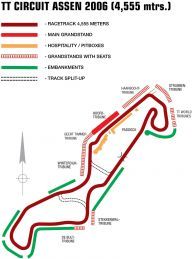 The prologue - Saturday 29 August 2009 - TT circuit Assen
The prologue - Saturday 29 August 2009 - TT circuit AssenThe Tour of Spain 2009 prologue will be organised on the circuit of Dutch TT / Moto GP on Saturday 29 August 2009.
This will be an individual time trial of 4,5 km, that is one full round on the circuit which is usually used for motor races.
 2/ Sunday 30 August 2009 - Assen > Emmen - 202 km
2/ Sunday 30 August 2009 - Assen > Emmen - 202 kmAfter the prologue which is presented as an appetizer for the rest of the Vuelta, the first stage will also start in Assen and the whole stage will take place in the province of Drenthe. The stage's route looks quite surprising with impressive loops which are used to come up with a stage of 202 kilometers while staying in the province of Drenthe. The stage is fully flat, but the Vuelta organisation has managed to find a 4th category hill in the nord of The Netherlands, the Cota de Witteveen (altitude: 30 m!).
3/ Monday 31 August 2009 - Zutphen > Venlo - 185 km
From Emmen the riders and their followers will have to go (about 130 km) to the province of Gelderland where they'll meet again at the start line of the stage in Zutphen.
This stage will go along the border between The Netherlands and Germany (with a very short visit to the county laying on the east side of the The Netherlands) towards the south of the country and the province of Limburg and more precisely to the finish line in Venlo.
According to the Vuelta organisation the riders will go over some cobble stone roads which will be avoided in case of bad weather to prevent from getting problems since the riders will already be a bit nervous because of riding one of the first stages of the Vuelta. Furthermore, the organisation indicates that the time bonuses which can be taken at intermediate sprints and at the finish will probably lead to another rider wearing the golden leader jersey.
4/ Tuesday 1er September 2009 - Venlo > Liège (Belgium) - 224 km
On the first day of September the riders will leave The Netherlands do go to Belgium and more precisely to Liège.
During this stage they will climb the Cauberg (4th category; altitude: 150 m) twice and the Mont Theux (4th category; altitude: 338 m) at the end of the stage.
The Cauberg, close to Valkenburg, is especially known from the Amstel Gold Race which puts up its finish line on top of it since 2003, several World Championships and two Tour de France stage finishes (on 11 July 1992 the stage finish on top of the Cauberg and on 4 July 2006 the finish was just after the climb of the Cauberg).
With its 224 kilometers, this stage is the longest of the Vuelta 2009.
After this stage the riders will take the plan from the Liège airport towards the autonomic region of Catalonia ... And the organiser might well get some comments from riders and followers for this because taking the plane immediately after the longest stage probably isn't that much fun and the Vuelta followers will have to make the trip ... by car!
Fortunately the next day, Wednesday 2 September 2009, is the first rest day of this Tour of Spain.
The map
Below you'll find the map of this first part of the Vuelta a España 2009 (© Unipublic). I cut the official map in two because I feel I can't present it the way Unipublic does with only a small space between The Netherlands and Spain which represents both Belgium and France ;-).
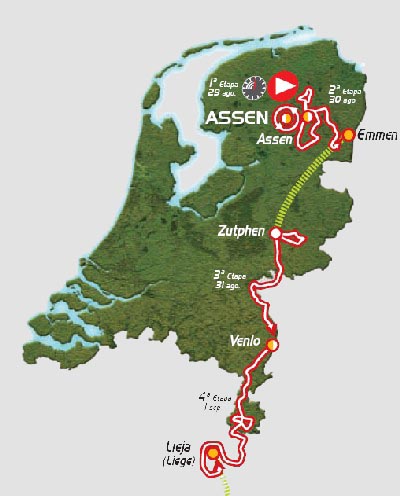
The website
The local organisation committee has put up a website to inform people about the start of the Vuelta 2009 from the province of Drenthe.
At vueltadrenthe.nl one can of course find all the news about the start and the first stages, the maps of the first stages and informations about the organisation committee but also the first informations about an amateur ride linked to the Vuelta which can be done in 60, 90 or 120 kilometers the morning of the prologue.
The Vuelta finally in Spain
After these first 3 stages and the prologue the Vuelta finally arrives in Spain, first of all for the first rest day on Wednesday 2 September and to go on with the 5th stage.5/ Thursday 3 September 2009 - Tarragona > Vinarós - 174 km
The first stage in Spain will start in the beautiful city Tarragona and go towards the city Vinarós 174 kilometers from there. The riders will find the first two real mountains on their way, the Alto de Fatxas (altitude: 510 m) of the second category and the Alto de Benifallet of the third category (altitude: 360 m).
At 6 kilometers from the finish they will pass in front of the Ermita de la Misericordia church which is placed on top of a small hill.
6/ Friday 4 September 2009 - Xativá > Xativá - 186 km
220 kilometers from the city where the stage finished the day before, the riders will meet again in Xativá for the start of the 6th stage.
This stage will loop around this city and contains three mountains: first the Alto de la Muela of the second category (altitude: 610 m) followed by two mountains of the third category which have never been part of the Vuelta before, the Alto Millares (altitude: 560 m) and the Alto de Beniganim (altitude: 320 m).
7/ Saturday 5 September 2009 - Valencia - contre-la-montre individuel - 30 km
Usually the Grand Tours try to come up with a good show on Saturdays and this will also be the case for the Vuelta 2009. Indeed, that day the riders will compete individually in a loop around the city Valencia. After the TT motor circuit during the prologue in Assen in The Netherlands, this stage's route contains the Formule 1 circuit of the city.
8/ Sunday 6 September 2009 - Alzira > Alto de Aitana - 206 km
Between the start and finish city of the 6th stage and the city around which the individual time trial is done, is the start city of the 8th stage, Alzira.
This will be the first big mountain stage with no less than 7 mountains!
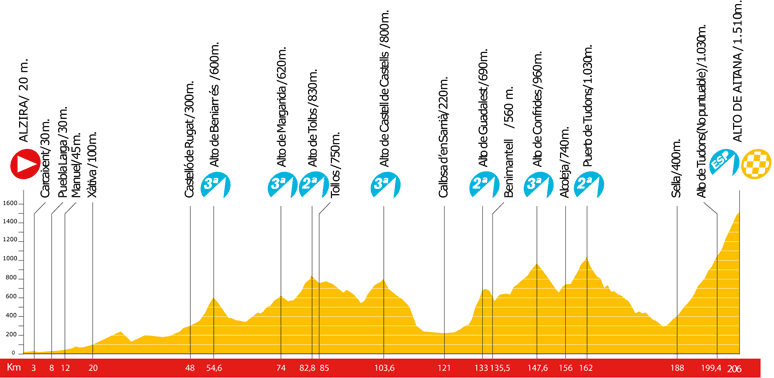
The profile of the 8th stage - Alzira > Alto de Aitana
The first mountain is a 3rd category of which the top will be reached after 54,6 km, the Alto de Beniarres (altitude: 600 m) which has never before been part of the Vuelta. After the descent will follow the succession of the Alto de Margarida (3rd category, altitude: 620 m) and the Alto de Tollos (2nd category, altitude: 830 m).
After a short descent the riders will continue with the Alto de Castell de Castells (3rd category, altitude: 800 m) which is also new for the Vuelta and a long descent before they start the steep climb of the Alto de Guadalest which is also new (2nd category, altitude: 690 m). They will than continue on the Alto de Confrides (3rd, 960 m) and the Puerto de Tudons (2nd, 1030 m).
After all these mountains made for real climbers, the riders haven't finished yet because after a long descent towards Sella they can finally start with the climb towards the finish on top of the Alto Base de Aitana (out of category, altitude: 1510 m).
9/ Monday 7 September 2009 - Alcoy > Xorret del Catí - 186 km
After the difficult stage the day before, the riders will continue with another mountain stage which will loop in a very special way to go from Alcoy to Xorret del Catí.
During this stage the riders will have to climb 7 mountains as well.
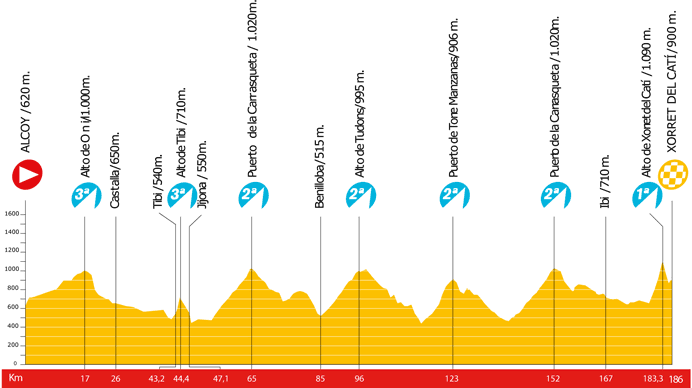
The profile of the 9th stage - Alcoy > Xorret del Catí
Right from the start they will start the climb to the top of the Alto de Onil, a third category mountain (altitude: 1000 m) which has never been part of a Vuelta stage before. After a long descent they'll continue with the climb of the Alto de Tibi, short but steep, of the 3rd category (altitude: 710 m) and the Puerto de la Carrasqueta (2nd category, altitude: 1020 m).
In a repeated cycle of descents and climbs we'll trouve the Alto de Tudons (2nd category, altitude: 995 m) which was already part of the final climb to the finish of the day before, the Puerto de Torre Manzanas (2nd, 906 m) and the Puerto de la Carrasqueta (2nd, 1020 m). After a slow but long descent the riders can finally start their final climb to the Alto de Xorret de Catí which has its top (1090 m, 1st category) at a little bit under 3 kilometers from the finish line.
10/ Tuesday 8 September 2009 - Alicante > Murcia - 162 km
The start of the 10th stage will be in the seaport town Alicante. This stage is the first one which will arrive in the Autonomous region of Murcia with the finish in its capital, Murcia.
Even though the stage starts with a slow climb during almost half of the stage, the only mountain of this stage is the Alto de la Cresta del Gallo of the second category (altitude: 400 m) at about 12 kilometers of the finish.
11/ Wednesday 9 September 2009 - Murcia > Caravaca de la Cruz - 191 km
The next day the riders will meet again at the start line in Murcia for a 191 kilometer mountain stage.
During this stage, towards the holy city of Caravaca de la Ceruz (in 2004 the Vuelta already had a stage finish there), the riders will climb 3 mountains which have never been climbed before in the Vuelta: first the Alto Collado Bermejo of the first category (altitude: 1200 m) with its top after about 53 kilometers, followed by the Alto de Zarzadilla (3rd category, altitude: 1030 m) about 30 kilometers further and the Alto de Moratalla (2nd, 1240 m) at about 30 kilometers from the finish.
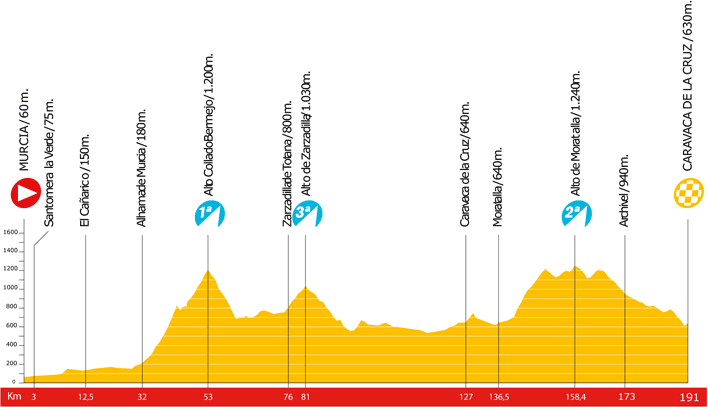
The profile of the 11th stage - Murcia > Caravaca de la Cruz
Thursday 10 September 2009 - rest day
8 days after the first rest day which allowed the riders to go from Liège in Belgium to Tarragona in Spain, the riders can again get some rest during the second rest day. This second rest day will be used for a new transfer, this time to the south of Spain, more precisely to the city Almería (about 200 kilometers).
12/ Friday 11 September 2009 - Almería > Alto de Velefique - 191 km
Hopefully the riders have managed to get some rest during the second rest day, because this Friday there will be a new mountain stage which is the first in three during this weekend.
This stage's route bridges a 3.550 metre difference in altitude with the Alto de Velefique (1st category, altitude: 1840 m) and the first crossing of the finish line after 55,6 kilometers, the Alto de Calar Alto (1st, 1980 m), the Alto de Filabres (3rd, 1280 m), new in the Vuelta and finally the second climb to the mountain top finish on the Alto de Velefique.
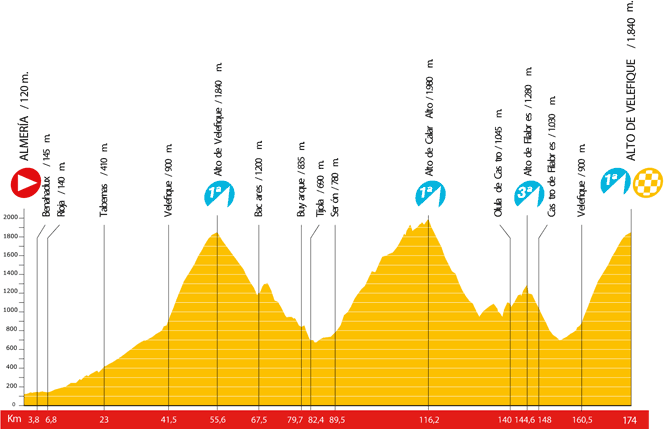
The profile of the 12nd stage - Almería > Alto de Velefique
13/ Saturday 12 September 2009 - Berja > Sierra Nevada - 175 km
The second stage in Andalousia and again a beautiful mountain stage with mountain top finish.
Indeed, after a short climb right from the start, to the top of the Alto de Berja (3rd category, altitude: 840 m) which will be reached after 13 kilometers, the riders will continue with the Puerto de la Ragua (1st category, altitude: 2000 m) which has never before been part of the Vuelta. At 60 kilometers from the finish they'll arrive on top of the Puerto Los Blancares (3rd, 1290 m) and after its descent to Granada, they will start the final climb of the Alto de Monachil (1st, 1510 m) which continues onto the Alto de Sierra Nevada (out of category, 2520 m) for a total climb of 25 kilometers.
This will be the roof top of the Vuelta.
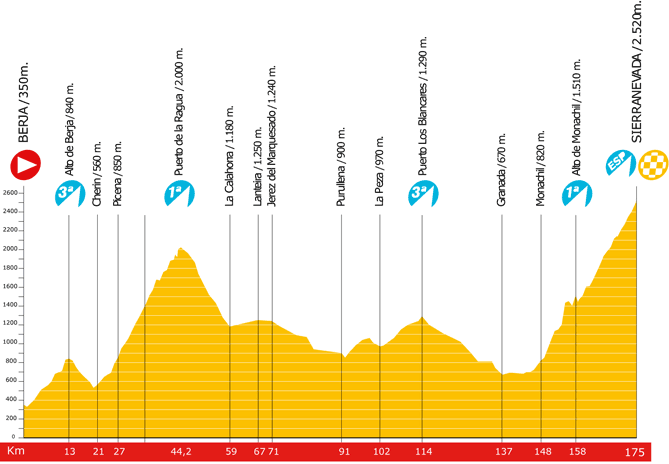
The profile of the 13rd stage - Berja > Sierra Nevada
14/ Sunday 13 September 2009 - Granada > Sierra de la Pandera - 157 km
As if the two previous stages weren't difficult enough, the Vuelta will continue with a third mountain stage which starts in Granada and finishes in Sierra de la Pandera in the province of Jaén (in Andalusia) which will be visited for the 4th time by the Vuelta.
After the climb of two small mountains, the Alto de las Encebras (3rd category, altitude: 1140 m) and the Alto de Huelma (3rd, 1167 m), it's time for the descent to the city of Jaén through a paved route close to the cathedral and the climb of the Alto de lo Villares (2nd category, altitude: 1200 m) qui donne accès à la montée finale de la Sierra de la Pandera (hors category, 1840 m) of 9 kilometers at 8% on average.
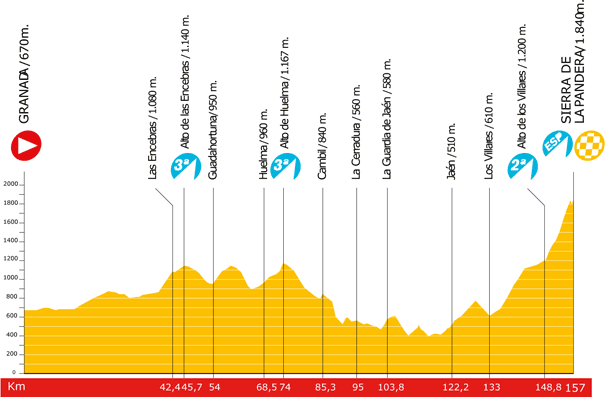
The profile of the 14th stage - Granada > Sierra de la Pandera
15/ Monday 14 September 2009 - Jaén > Córdoba - 168 km
After having passed through the city Jaén the day before, this will be the start city of Monday 14 September's stage which will be much easier than the 3 previous ones. We should however not forget the Alto del Catorce por ciento (2nd category, altitude: 560 m) which is at 20 kilometers from the finish in Córdoba and which will for the first time be part of the Vuelta.
16/ Tuesday 15 September 2009 - Córdoba > Puertollano - 170 km
A stage which will be really cool compared to some of the previous ones with only two third category mountains at the start of the stage, the Alto de los Villares (altitude: 580 m) and the Puerto de la Chimorra (altitude: 730 m).
The Vuelta organiser does however announce that the route is very sinuous, or in a local dialect muy pestoso.
17/ Wednesday 16 September 2009 - Ciudad Real > Talavera de la Reina - 175 km
This Wednesday there will be a real plain stage and the last chance for the sprinters apart from the very final stage finish in Madrid. Big chance thus that the winner will sprint towards the finish line in Talavera de la Reina, the city which is known for its traditional les Mondas celebration.
18/ Thursday 17 September 2009 - Talavera de la Reina > Ávila - 187 km
After the plain stage the day before, there will be yet another mountain stage which will start in the city where the riders finished the day before, Talavera de la Reina, for 187 kilometers which could well have a heavy impact on the general ranking. Indeed, this stage contains 4 mountains: the Alto Pielago of the second category (altitude: 1120 m), the Puerto de Mijares of the first category (1570 m), the Alto Mediano (2nd category, 1380 m) and finally the Alto de Boquerón (3rd, 1310 m). Only the Puerto de Mijares has ever been visited before by the Vuelta, the other three climbs are completely new.
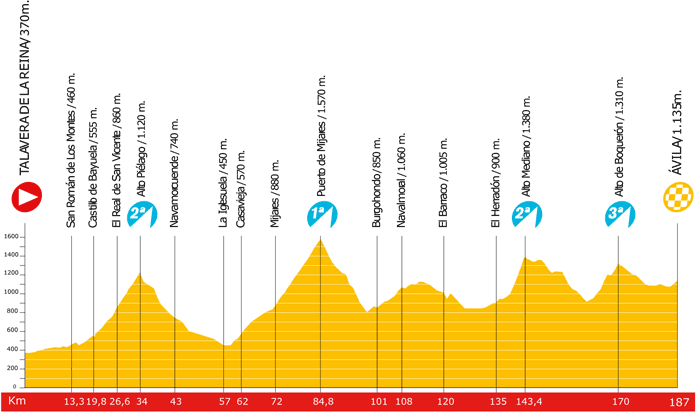
The profile of the 18th stage - Talavera de la Reina > Ávila
19/ Friday 18 September 2009 - Ávila > La Granja. Real Fábrica de Cristales - 174 km
Again a mountain stage, the last one of this Vuelta, between the city where the previous day's stage finished, Ávila, and the finish line which will be at the National Glass Museum in La Granja.
After a first sinuous part up to El Espinar during which we'll probably see one of more riders or groups attack to get away from the pack, they will climb the Alto del Léon (3rd, 1510 m), the Alto Navacerrada (1st, 1870 m), the Puerto de la Morcuera (2nd, 1795 m) and finally again the Puerto de Navacerrada (1st, 1870 m) with its top at 17 kilometers from the finish line.
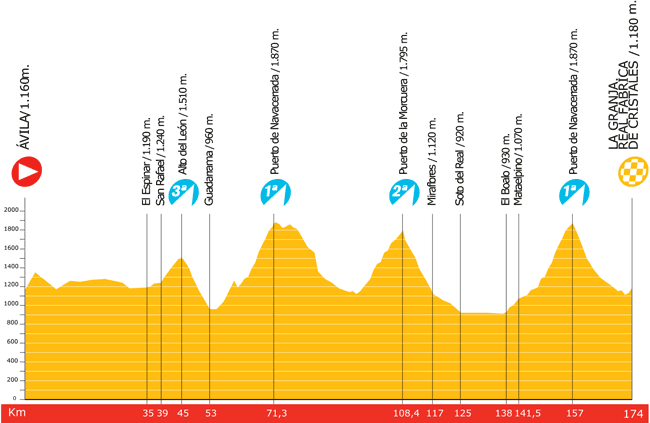
The profile of the 19th stage - Ávila > La Granja
20/ Saturday 19 September 2009 - Toledo > Toledo - individual time trial - 26 km
After a transfer of about 250 kilometers, the forelast stage will be an individual time trial with its start and finish in Toledo. The route of this stage partly corresponds to the route taken in 2008 when the Vuelta arrived in Toledo.
After this stage we'll finally know the name of the rider who will wear the oro jersey on the last day and who probably wins this 64th edition of the Vuelta.

Toledo - © Diliff
21/ Sunday 20 September 2009 - Rivas-Vaciamadrid > Madrid - 110 km
The very final stage is a 110 kilometer plain stage towards the usual circuit on the Paseo de la Castellana in Madrid. As usual in the last few years, the finish line will be on the Plaza de Cibeles and a sprinter will probably cross it first ...
The map
After the first part of the map earlier in this article (for the part in The Netherlands and in Belgium), here's the rest of the route with the Spanish stages:
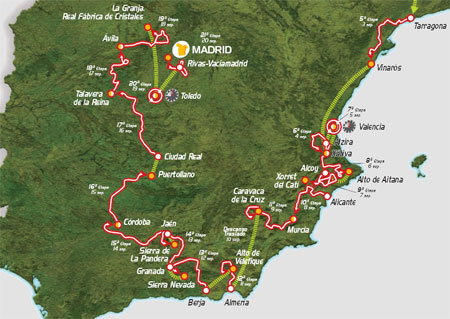
CONTINUE READING AFTER THIS ADVERTISEMENT
The Vuelta at letour.fr
Since A.S.O., the organiser of the Tour de France among others, now has a 49% share in the Vuelta a España, the letour.fr web site announced since the end of last week that at the same time as the presentation of the route of the 64th edition in the Spanish capital, it will (would) both be available on the race's official website, lavuelta.com, and on letour.fr.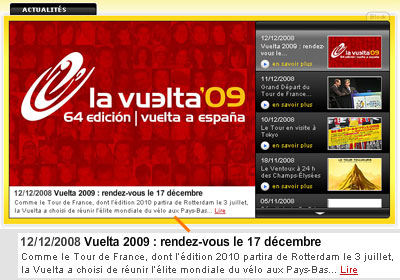
The Vuelta announcement at letour.fr ... which stayed there a little too long!
However, all cycling fans who tried to find information there on the day of the presentation, on 17 December, and at least part of the next day left disappointed since there was nothing more to see than this simple announcement ...
Since a few days we finally find a video of the Vuelta route there!
A video of the full route
Just like the Tour de France, the Vuelta a España 2009 route is now available as a video on YouTube!This video is very complete with a global view of each stage followed by an animation of the stage's route and profile after a zoom on the map. Based on this video it's theoretically possible to create a map of the Vuelta 2009 route in Google Maps/Google Earth, so if someone has some time to spend and comes up with such a map, I'm of course very interested to integrate it in this article :-)!
Vond u dit artikel interessant? Laat het uw vrienden op Facebook weten door op de buttons hieronder te klikken!
2 comments | 32632 views
this publication is published in: Vuelta a España | Cycling general (except Tour de France) | Vuelta a España 2009





 by marco1988 over
by marco1988 over
Encore une très bonne documentation. Bravo au Webmaster.
la vuelta 2009 est l une des meilleurs courses cette année vu le tracé du parcours